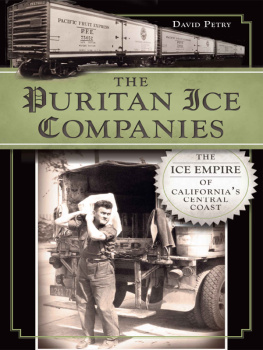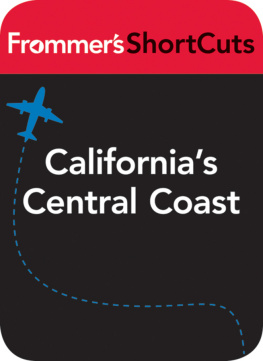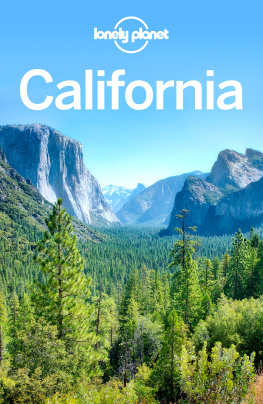

Puritan Ice, Santa Barbara, plant #1, circa 1923. Connie Phillips collection.
Published by The History Press
Charleston, SC 29403
www.historypress.net
Copyright 2012 by David Petry
All rights reserved
First published 2012
e-book edition 2012
Manufactured in the United States
ISBN 978.1.61423.809.6
Library of Congress CIP data applied for.
print edition ISBN 978.1.60949.877.1
Notice: The information in this book is true and complete to the best of our knowledge. It is offered without guarantee on the part of the author or The History Press. The author and The History Press disclaim all liability in connection with the use of this book.
All rights reserved. No part of this book may be reproduced or transmitted in any form whatsoever without prior written permission from the publisher except in the case of brief quotations embodied in critical articles and reviews.
To John Fritsche
Contents
Introduction
The fifty years from 1895 through 1945 could be called the Great American Ice Age. During these years, ice reinvented our railroads, reinvented our food, reinvented our economy and reinvented even our communities. In 1895, more people lived within five miles of a farm than not. Only a small percentage of food traveled beyond twenty miles, a long days travel with a horse and cart. The food that did travel, like potatoes and corn, was hardy and needed no cooling. Or it was livestock on the hoof, expensive, difficult and very inefficient.
By 1945, America was a different place. Instead of people spread like butter over the farmland and fledgling cities, now the cities boomed and drained the farmlands of people. Foodmuch more food than could have been imagined fifty years earliertraveled, and it routinely traveled thousands of miles.
Ice was the medium that allowed so many changes to occur in such a short time frame.
The massive change, when it came down to it, was a simple distribution problem. How could Americans grow, package, move, distribute, store and market fresh foods to get them to the places where the population was moving? The answer seemed simple as well.
Logically, closing the gulf between rural grower and city grocer was a problem the grower or grocer would naturally want to solve. But put anything in placea proposition, an idea, a businessand it will only roll downhill if the underlying conditions are right. For the grower-to-grocer problem, the distances were too great, the costs too high and the risks too real.

Ice hooks, Puritan Ice, Guadalupe plant #2, 2010. Photo by David Petry.
The growers were dispersed, unorganized, small and undercapitalized. The grocers of 1895 were in the same boat. And food was not like steel; profit margins were far too small to bear the cost of a national infrastructure. It was only through the Great American Ice Age that parties on both ends of the line created cooperatives, consolidated and merged and began to form regional and even national companies.
But at the beginning, it was the rail companies that found it in their best interests to step up. They created and then heavily optimized the infrastructure to make it work. One of the central requirements of the infrastructure was ice to keep the produce cool. It was the rail companies that developed and built rail cars with ice bunkers. And in many cases, it was the rail companies that manufactured the ice at hundreds of plants along the way.
The rail and ice industries quickly consolidated and were run by regional monopolies. There were start-ups, but the small rail and ice companies were either bought out or priced out of existence. Capital in the massive rail and ice firms moved like tides; prices could drop or contracts dry up, and independent firms all too often found themselves with expensive, brand-new plants and no market.
One of the very few local ice companies that escaped this fate was Puritan Ice of Santa Barbara, operating from 1922 to 1986. Somehow the founders obtained insider knowledge and privilege in order to not just be in the right place at the right time but also to gain and maintain a permanent immunity, even when the company bumped up against giants like Union Ice of San Francisco.
An unaccountable anachronism in the ice world, Puritan was a company that reflected and embodied the larger trends and developments in the country.
Puritan Ice was central in the creation of food development, both produce and poultry. Almost single-handedly, Puritan created or significantly expanded the agricultural markets for Guadalupe, Santa Maria, Lompoc, Atascadero, Oxnard and Blythe. In the course of the companys trajectory, it helped establish the Japanese growers in the Santa Maria Valley and then supplanted them with Mexican braceros during World War II. Puritan developed the largest egg and poultry farm on earth in Atascadero. It fought for and won the domestic ice business in Santa Barbara, Lompoc and Guadalupe. The company went to Blythe, California, where it more than doubled agricultural production in the valley and served the ice needs of General Pattons Desert Training Center.

Exterior, Puritan Ice, Guadalupe plant #2, 2010. Photo by David Petry.
Puritan then transformed itself in the face of the advent of frozen foods and mechanically refrigerated trucks. The company introduced vacuum pre-coolinga process by which produce was chilled prior to loadingand the addition of blowers to fill loaded rail cars and trucks with crushed ice.
But soon the ice business was melting away. Puritan diversified into feedlots, equipment leasing and distribution, specifically of Pepsi-Cola. With a few of the ice plants still in operation, the leasing firm took on clients like Motel 6 and Sambos and, riding on the coattails of these companies successes, grew to open leasing offices in eighteen states.
The company is fascinating for all these reasons and more. How this underdog was able to find a toehold among successful monopolies, not just once but several times, is a story unto itself. How it straddled the Great Depression, rode out World War II and then ascended through the super-heated times of the 1960s and 70s like a rocket are all interesting facets of a unique and agile company. Even the companys demise in 1986 was on a high note.
Yet the ice industry in Santa Barbara was nearly invisible. The Puritan Ice plant stood a half block from the beach, at 325 East Cabrillo Boulevard. Though it produced fifty tons of ice daily, most residents in town never noticed the building, much less knew what was done inside. The plant was shielded by a row of trees, and the building was a utilitarian cluster of white rectangles.
Invisible or not, Puritan Ice was a linchpin to history. Located in Santa Barbara, it connected Californias northern Central Coast to the south and connected this region of California to the eastern United States. To understand Puritan is to understand a critical moment in both human and regional history.
Chapter 1
Ice on the California Riviera
Some Santa Barbarans remember the red-and-white delivery trucks for the local ice company, emblazoned with Puritan IceBe Perspicacious! For several decades, ice deliverymen stopped at the back of every dining and grocery establishment and then drove their trucks out of the downtown corridor and delivered ice to every neighborhood in town.
Next page












